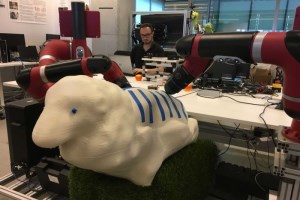Australia's wool industry is struggling to find shearers.
As a result, the industry is investing $10 million in research to streamline wool harvesting, including automation and robotics.
Such innovation is needed to address the labour shortage and give Australia’s wool industry a competitive edge globally.
Australia has 73 million sheep – about 50 percent less than it had three decades ago.
So, of course you’d expect fewer shearers – but their numbers have fallen alarmingly.
According to Australian Wool Innovation there are there are now only 2,800 shearers across the country – five times less than 30 years ago.
Many of them were lured out of the woolsheds into the mines during the resources boom.
And many New Zealanders, who have traditionally made up to half of Australia’s shearing workforce are staying home, thanks to a pay rise there.
Dr Jane Littlejohn, the general manager of research at Australian Wool Innovation Ltd, admits shearing is a tough job.
It’s physically demanding, backbreaking work with a high injury rate and big drop-out rate, she told Radio 2GB in a recent interview.
For this reason, the industry is now turning to technology to solve the labour shortage – and robots may provide a solution.
Robotics has come a long way
“But first the technology has to be tried and tested,” says Dr Littlejohn.
Robotics have come a long way in the 30 years since AWI first funded research into automated shearing, she says.
A research team at the University of Technology in Sydney has recently been exploring the possibilities of automated shearing for AWI.
Led by Dr Mickey Clemon in the UTS robotics lab, the team has developed a 3D printed sheep dubbed Shauna to test different ways of semi-automating sheep shearing.
So would these robotic arms replace a shearer, or is this meant to help a shearer?
“This is entirely meant to help a shearer,” Dr Clemon told ABC News recently. “This would reduce the amount of physical labour that a shearer would need to do in order to get the fleece wool off of the sheep.”
With the new automation, a shearer would load the sheep into some kind of restraint, the robot would shear the back and sides, and the shearer would do the rest.
Very promising outcome
“This is very promising and this tells us, gives us a very good indication that this is possible with off-the-shelf technology,” Dr Clemon says.
“In two years' time, we think we would have a product that could be transferred to an industry partner to do the commercial development.”
Dr Littlejohn oversees AWI's research program.
AWI is investing $10 million over the next five years on projects to automate wool harvesting, including one which would mechanise the entire process from sheep delivery to baled wool.
“If demand is going to grow and prices encourage more wool sheep on farms, we're going to have to look at ways to service that need for high quality wool harvesting,” she says.
Dr Littlejohn says by using robots cutting will be safer, with higher wool quality.
Better wool quality using robots
“We hope to raise the cutting mechanism higher off the skin surface, so you will get a cleaner ‘blow’ with the handpiece,” she says.
“There will be fewer ‘second’ cuts and less likelihood of a shearing injury or small cuts on sheep – these are the main benefits.
“This will result in better wool quality in the bale when it goes overseas.”
Will the advent of robotic shearing lead to further job losses in the industry?
Robotic shearing would be mainly aimed at wool growers with large flocks in the tens of thousands, Dr Littlejohn says.
“Growers with small flocks are unlikely to get an expensive contracting team of shearers with robots – so there will certainly be a place in the industry for shearers for a long time to come.”


